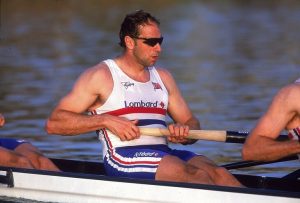Examples from five-time Olympic gold medalist Steve Redgrave and baseball legend David Wells
Type 2 diabetes develops slowly and is usually diagnosed in adulthood. Because of this, there are not many examples of professional athletes who continue their careers after diagnosis.
Rowing athlete Steve Redgrave won his first 4 Olympic gold medals by consuming about 7,000 calories a day and getting his energy mostly from carbohydrate foods.
Despite the fact that people with diabetes are encouraged to eat foods with a low glycemic index (GI)-that is, those that release energy gradually and don’t cause glucose spikes-Steve found it extremely difficult to follow this diet. When he was diagnosed, he was first switched to a low-sugar diet, but it didn’t help much – given that Steve exercised 4-5 times a day, his energy levels were dropping by noon. So Redgrave went back to a high-calorie diet and insulin injections eight to 10 times a day.

For 20 years now, Steve Redgrave hasn’t competed – although he says he’d like to – and so he doesn’t use as much glucose as he does when he’s preparing to compete. This forces him to inject much more insulin – because his body has nowhere else to burn glucose – and now Redgrave, like Max Domi, uses a pump.
There is a perception that type 2 diabetes is not as serious as type 1 diabetes, but it is not. People with type 2 diabetes also need constant glucose monitoring, diet, and medication. Initially, glucose levels are corrected with blood glucose-lowering medications, and if these are ineffective, insulin injections are resorted to.
An important point – physical activity and proper nutrition are therapeutic measures in type 2 diabetes, especially in the early period of the disease.
Both doctors and patients understand that strict dietary restrictions are difficult to maintain for a long time. It is much more effective to form an acceptable style of diet, which allows a person to reduce weight, and then maintain it at a comfortable level. Exercise helps in achieving this goal, so doctors include physical activity in the list of prescriptions.
Exercise is selected individually, necessarily taking into account age – as mentioned above, type 2 diabetes is often diagnosed at an older age. They are adjusted depending on comorbidities and may even be increased if tolerated well.
Former Major League Baseball (MLB) player David Wells was overweight his entire life and led a very hectic lifestyle.
When he was diagnosed with type 2 diabetes at age 43, Wells made major changes to his diet: eliminating alcohol and fast food, which had previously been an important part of his diet, as well as rice, pasta, potatoes, white bread and, in general, starches. As David points out, he can sometimes afford to skip a glass or two of red wine, but no more – unless he wants his type 2 diabetes to turn into insulin-dependent diabetes.

Doctors recommend that people with type 2 diabetes do aerobic exercise for 30-60 minutes at least three times a week, and ideally every day. The total duration is at least 150 minutes per week. One of the most successful types of physical activity for people with diabetes is Nordic walking, which “engages” 90% of the muscles of the whole body. As for contraindications and precautions, they are generally the same as for type 1 diabetes: the presence of complications and comorbidities, including coronary heart disease, joint and respiratory diseases.
If you have diabetes and are wondering if you should exercise, by all means do it! But it is necessary to observe a measure and to consult a doctor about the training regime, individual correction of nutrition and insulin doses – then and only then will sportive activities be able to improve both your physical and psycho-emotional state.
And be sure to share your diabetes story in the comments – it will help those who have recently learned their diagnosis.
